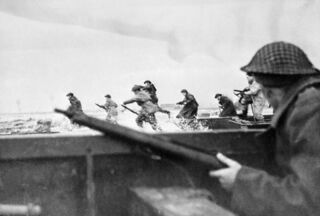Dongmak Beach (EWII)
This article is incomplete because it is pending further input from participants, or it is a work-in-progress by one author. Please comment on this article's talk page to share your input, comments and questions. Note: To contribute to this article, you may need to seek help from the author(s) of this page. |
| Dongmak Beach | |||||||
|---|---|---|---|---|---|---|---|
| Part of the Asianna and the Pacific Campaign of the Second Europan War | |||||||
 Troops of the Royal Regina Rifles assaulting Dongmak Beach | |||||||
| |||||||
| Belligerents | |||||||
| Commanders and leaders | |||||||
| Units involved | |||||||
| Casualties and losses | |||||||
|
1,479 dead or wounded 29 tanks |
3,497 dead or wounded 57 tanks | ||||||
Dongmak Beach is an 8-mile long beach on Joyonghea's west coast. The beach was the site of one of the biggest amphibious landings of the Second Europan War and the biggest to take place during the Third Joyonghean-Quenminese War. This was the first operation undertaken by the Rubrumians and Jutlanders on the Joyonghean Mainland. The beach was chosen as the most viable landing spot by General Harry Kurosawa due to its closer distance with the Joyonghean capital of Yeolcheon. Kurosawa was determined to land on the beach before nightfall. Facing them were elements of the Imperial Quenminese Army and the Regio Esercito under the command of Marshal Hồ Danh Sĩ Quốc.
The sectors were divided into 5, with the landing sectors for the Teulabians being in the middle of the Rubrumian and Jutlander sectors. Once the beach had been secured, 1 division per belligerent would land reserve forces and continue to march inland and destroying the artillery batteries at Dongmak Manor. The task of destroying the batteries fell to the Rubrumians. The Teulabians were to move through the villages and secure the eastern sections of the beach landing while the Jutlanders were to move westward. The Rubrumians would not only take the manor, but also advance further inland. Specialised tanks from the 4th Rubrumian Armoured Division participated in the clearing of the defenses.
The landings encountered heavy resistance from the defenders; the preliminary bombardment of the beaches proved less effective than had been hoped, and rough weather forced the first wave to be delayed until 0900 hours. Several assault companies, notably those of the Royal Regina Rifles, Princess Raphtalia's Jutlandish Light Infantry, and the 2nd Teulabian Infantry Regiment, took heavy casualties in the opening minutes of the first wave. It wasn't until 30 minutes later when the first tanks finally landed on the beach. Infantry marked important targets, such as AT emplacements, MG Nests, and bunkers for tanks to blast through. By 1035 hours, the landing beach had been cleared and the Allies moved inland. By 1100 hours, the reserves landed on the beach, further aiding Allied sweeping operations inland.
The subsequent push that followed achieved great results. Although the allies encountered stiff resistance from the deployed Steel Tiger and Eagle Strike Division, they were able to make their way to the manor house and destroyed the guns. The Archadians deployed at around 1300 hours, encountering Jutlandish forces west of the beach landing but suffered heavy casualties due to poor coordination with the intended area of attack. The Archadians had been ordered to attack the eastern sector, where the Teulabians had been conducting sweeping operations but had failed to find their objectives. By the time all operations came to a halt at 2100 hours, the Royal Regina Rifles had achieved its intended objective, being only just 25 kms away from In'chon and 10 kms away from Gimpo.
The landing at Dongmak is considered by many historians to be one of smoothest examples of amphibious landings in history, with the Allies successfully achieving more than the expected objective area as it was not expected that the Rubrumians would already be at the highway to Gimpo and In'chon and suffering fewer casualties than expected from many amphibious landings that had occurred during the conflict.